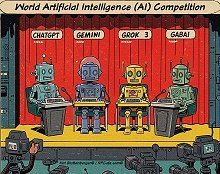Electronics & Technology
- See Full List of AI Topics -

The Rutherford-Bohr atomic model, also known as the Bohr model, was proposed
by Ernest
Rutherford and Niels
Bohr in 1913. The model describes the structure of atoms and explains the
observed behavior of electrons in atoms.
Prior to the Rutherford-Bohr model, the prevailing view of the atomic
structure was based on the plum pudding model proposed by J.J. Thomson.
According to this model, the atom was thought to be a positively charged sphere
with negatively charged electrons embedded in it.
However, in 1911, Ernest Rutherford and his colleagues performed an
experiment in which they bombarded a thin gold foil with alpha particles. The
results of this experiment led to the conclusion that the atom had a dense,
positively charged nucleus at its center, which was surrounded by negatively
charged electrons.
Building on Rutherford's discovery, Niels Bohr proposed a model of the atom
that explained how electrons could orbit the nucleus without losing energy. Bohr
suggested that electrons could only occupy specific energy levels, or shells,
around the nucleus. When an electron moved from one energy level to another, it
would either absorb or emit a photon of light.
The Bohr model also explained the observed spectrum of hydrogen. Bohr
suggested that the energy of the emitted photons corresponded to the energy
difference between the electron's initial and final energy levels. This theory
also helped to explain why certain colors were observed in the spectrum of
hydrogen.
Despite its success in explaining certain phenomena, the Bohr model had
limitations. It could only describe the behavior of hydrogen atoms, and it was
unable to explain the fine structure of the atomic spectrum, which became
apparent with more precise measurements.
The Rutherford-Bohr atomic model was an important milestone in the
development of atomic theory. It helped to establish the idea of quantization of
energy levels and provided a basis for the understanding of chemical reactions
and the behavior of atoms in electric and magnetic fields. While the model has
been refined and expanded upon in the century since its proposal, it remains an
important foundation for our understanding of the structure of atoms.
 This content was generated by primarily
with the assistance of ChatGPT (OpenAI), and/or
Gemini (Google), and/or
Arya (GabAI), and/or Grok
(x.AI), and/or DeepSeek artificial intelligence
(AI) engines. Review was performed to help detect and correct any inaccuracies; however,
you are encouraged to verify the information yourself if it will be used for critical
applications. In all cases, multiple solicitations to the AI engine(s) was(were)
used to assimilate final content. Images and external hyperlinks have also been
added occasionally - especially on extensive treatises. Courts have ruled that AI-generated
content is not subject to copyright restrictions, but since I modify them, everything
here is protected by RF Cafe copyright. Many of the images are likewise generated
and modified. Your use of this data implies an agreement to hold totally harmless
Kirt Blattenberger, RF Cafe, and any and all of its assigns. Thank you. Here is
Gab AI in an iFrame. This content was generated by primarily
with the assistance of ChatGPT (OpenAI), and/or
Gemini (Google), and/or
Arya (GabAI), and/or Grok
(x.AI), and/or DeepSeek artificial intelligence
(AI) engines. Review was performed to help detect and correct any inaccuracies; however,
you are encouraged to verify the information yourself if it will be used for critical
applications. In all cases, multiple solicitations to the AI engine(s) was(were)
used to assimilate final content. Images and external hyperlinks have also been
added occasionally - especially on extensive treatises. Courts have ruled that AI-generated
content is not subject to copyright restrictions, but since I modify them, everything
here is protected by RF Cafe copyright. Many of the images are likewise generated
and modified. Your use of this data implies an agreement to hold totally harmless
Kirt Blattenberger, RF Cafe, and any and all of its assigns. Thank you. Here is
Gab AI in an iFrame.
AI Technical Trustability Update
While working on an update to my
RF Cafe Espresso Engineering Workbook project to add a couple calculators about
FM sidebands (available soon). The good news is that AI provided excellent VBA code
to generate a set of Bessel function
plots. The bad news is when I asked for a
table
showing at which modulation indices sidebands 0 (carrier) through 5 vanish,
none of the agents got it right. Some were really bad. The AI agents typically explain
their reason and method correctly, then go on to produces bad results. Even after
pointing out errors, subsequent results are still wrong. I do a lot of AI work
and see this often, even with subscribing to professional versions. I ultimately
generated the table myself. There is going to be a lot of inaccurate information
out there based on unverified AI queries, so beware.
Electronics & High Tech
Companies | Electronics &
Tech Publications | Electronics &
Tech Pioneers | Electronics &
Tech Principles |
Tech Standards Groups &
Industry Associations | Societal
Influences on Technology
|









